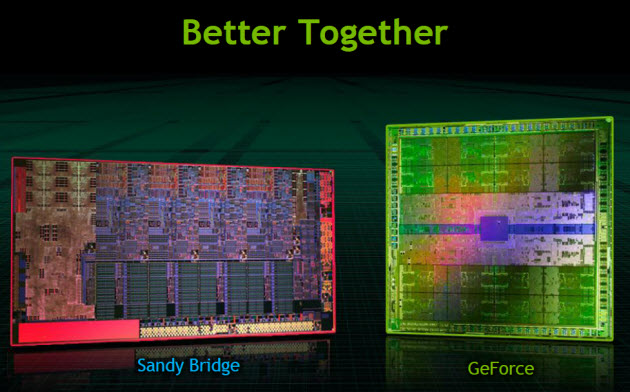 Intel and Advanced Micro Devices are talking like the best days of the stand-alone graphics chip are over. Both have combo chips coming early next year that pack a microprocessor and graphics processor in the same chip. That’s supposed to be bad news for Nvidia, but the feisty graphics chip maker — the last company left standing after more than a decade of Darwinian competition — says that its demise is being exaggerated once again.
Intel and Advanced Micro Devices are talking like the best days of the stand-alone graphics chip are over. Both have combo chips coming early next year that pack a microprocessor and graphics processor in the same chip. That’s supposed to be bad news for Nvidia, but the feisty graphics chip maker — the last company left standing after more than a decade of Darwinian competition — says that its demise is being exaggerated once again.
If Nvidia starts losing, the balance of power would change in the PC industry, shifting from the triumvirate that rules now to a duopoly. But Santa Clara, Calif.-based Nvidia claims that PC manufacturers are getting ready to launch a record 200 new computers in the first half of 2011 that feature Nvidia’s GeForce graphics chips. Those chips will be paired with Intel’s Sandy Bridge microprocessors, which is the code name for the combo chips.
In other words, computer makers are buying combo chips with Intel graphics integrated into them, but those aren’t going to be good enough. So the computer makers are also including Nvidia graphics chips, said David Ragones, director of product marketing at Nvidia, in an interview. Based on the number of design wins, Ragones said Nvidia believes it could gain market share in 2011. Nvidia’s chips have been designed into laptops and desktops being created by Acer, Alienware, ASUS, Dell, Fujitsu-Siemens, HP, Lenovo, Samsung, Sony, Toshiba and more.
Intel has also tossed out a lot of bluster about the acceptance of Sandy Bridge by computer makers. While past Intel chips have been brain-dead when it comes to graphics, Intel has invested more heavily in creating better graphics for Sandy Bridge. Apple has reportedly dumped Nvidia from its unannounced line of MacBook laptops coming early next year; Apple has supposedly turned to Intel’s Sandy Bridge and AMD’s Fusion. Still, Nvidia is firmly planted in Apple’s popular MacBook Air laptop. Apple is a trendsetter when it comes to designing state-of-the-art computers.
But Ragones believes that computer makers are also throwing in discrete graphics chips because the Intel processor can’t do the job, particularly when it comes to playing games, which are one of the most popular activities on the PC. The explosion in digital entertainment has been good for Nvidia, and that shows no signs of abating.
 Ragones says that demand for graphics processing power is also growing because of its usefulness in video editing, web browsing (especially with the newer HTML5 browsers), and 3D movies. Roughly half of the top 30 games on the market won’t run on Intel combo chips, Ragones said. Nvidia has also made good headway getting its Optimus technology accepted. The Optimus technology measures the needs of an application and turns off the main graphics chip if it isn’t necessary, thereby saving power consumption.
Ragones says that demand for graphics processing power is also growing because of its usefulness in video editing, web browsing (especially with the newer HTML5 browsers), and 3D movies. Roughly half of the top 30 games on the market won’t run on Intel combo chips, Ragones said. Nvidia has also made good headway getting its Optimus technology accepted. The Optimus technology measures the needs of an application and turns off the main graphics chip if it isn’t necessary, thereby saving power consumption.
AMD’s combo chips are another story. AMD has much better graphics processing in its combo chips, dubbed Fusion, in part because AMD makes the Radeon series of stand-alone graphics chips that compete directly with Nvidia’s chips. The two graphics chip makers are still slugging it out in discrete chips. My guess is that computer makers are less likely to use Nvidia stand-alone graphics if they have chosen Fusion chips. But the good news for Nvidia is that Intel still has roughly 80 percent of the microprocessor market.
Dean McCarron, an analyst for Mercury Research, said that demand from computer makers for stand-alone graphics chips remains strong and above historic levels. He projects healthy growth ahead for discrete graphics chips, whose unit shipments are expected to double from 2009 to 2014.



